Project Audit & Quality Assessment Models
Info: 17027 words (68 pages) Dissertation
Published: 27th Jan 2022
Tagged: AccountingProject Management
ABSTRACT
Project allocation and implementation in various organizations has been major scenario to fulfill the need of owner/contractor. There has been numerous types of projects implemented in the commercial market till data. This project could be any type from linear to multilevel or small to large. Project administration and planning are always a crucial factors among the other factors of success for any project. This projects are mainly concerned to cultivate major outcomes relating to cost, time and quality among any other aspects of project. Conventional projects are mainly intended to fulfill constraint strategic goals which usually forbid implementation to any of the modern project structure. Many organizations have seen insufficiency in their project structure which enforce them to either cancel or re plan their project strategies to reach desired goal. Project strategies are basically evolved to balance project cost, time and quality in accordance to achieve relative targets. Modern project objectives has diminished various scenario relating to conventional project management system. Hence, new project monitoring system required to implement by various organizations.
One of this quality assurance method to evaluate project quality is project Auditing. Project auditing has been widely nominated way to monitor project performance. This report is intended to identify need of project auditing and various types of project audit models. The main objective of the project is to outline project and its important followed by importance of project audit in its assessment. This report will also identify various project audit models and its advantages. Ranking and comparison of these models will give enhanced notion about most suitable project audit model for project assessment. In nut shell, recommendation of project auditing method has been given to assess project quality & performance based on its scale.
ACRONYMS
APM – Association for Project Management
P3M3 – Portfolio, Program and Project Management Maturity Model
CMMI – Capability Maturity Model Integration
PMI – Project Management Institute
SEI – Software Engineering Institute
OGC – Office of Government Commerce
P2MM – Prince2 Maturity Model
EFQM – European Foundation for Quality Management
RADAR – Result Approach Development Assessment and Refinement
OHSM – Occupational Health & Safety Management
KPM3 – Kerzner Project Management Maturity Model
P-CMM – People Capability Maturity Model
MPP – Measuring Project Performance Tool
PHT – Project Health Check Tool
PQC – Practice Questionnaire Corporate
GC – General Contractor
CHAPTER ONE: Introduction to Project Management
A project is carried out to achieve desirable result in specific timeframe with effective utilization of allocated resources (fund, equipment). Therefore, project is not only constrained by time but also by funding and quality of work. Hence, Projects need to be managed to meet their objectives. So we can say that Project management is the all about achieving specific (predetermined) goals with planning, organizing, motivating, and controlling resources. The prime challenge of project management is to achieve all of the project goals and objectives while honoring the constraints on scope, quality, cost and time. [1]
1.1 Various Definitions of Project Management
A Project is a temporary organization that is created for the purpose of delivering one or more business products according to an agreed Business Case.-PRINCE2.
An endeavor in which human material and financial resources are organized in a novel way to deliver a unique scope of work of given specification often within constraints of cost and time to achieve beneficial changes defined by quantitative and qualitative objectives.- Association for Project Management (APM)
Project management is the planning, organizing, directing and controlling of company resources for a relatively short-term objective that has been established to complete specific goals and objectives. [1]
Furthermore, project management utilizes the systems approach to management by having functional personnel (the vertical hierarchy) assigned to a specific project (the horizontal hierarchy) (2009) according to H. Kerzner [1]
1.2 Project Audit
Projects are always planned to achieve desirable predetermined result. However, in most of the cases it is next to impossible to achieve all objectives in specified time frame. Hence, during the project some kind of system is required in order to track the performance and get maximum performance. “PROJECT AUDIT” is such a system so nowadays it has become inevitable as it investigate the work quality with time schedule and accelerate work progress. Main aim of Project audit is to investigate parameters which are hindrance to project progress [1] [2]
Definition According to European project center, “Project audit is a standards verification process of the extent to which project has been compiled with rules and principal of project management” [3]… Project audit can be performed at any stage including closing, conception stage. Generally, scope of project audit is decided by owner. Mostly we can describe the project audit in manly two categories 1) Performance based 2) financial based or sometimes combination of both.
Main aim of financial audit is to obtain assurance about financial statement so in this process, we try to find out any error or fraud in financial statement. While, work on time, Quality of work, employee (labor) audit are most essential parameters of performance based audit.
During Project Audit process, sometimes owner hire the third party (outside consultant) while sometimes team from their own internal department is given the responsibility. Owner decide the specific objectives of audit by deciding specific issues and questions to be investigated. After that, it is owner’s responsibility to provide all necessary document from his side as well as contractor’s side (in case construction project). [3]
In construction project, owner asks contractors to keep records of labor, cost, material etc. and may require all these documents during audit process. These records may be requested for review during the audit, including the following. [3]
A project auditing can be categorized of the following stages; [3]
- Audit Interview
- In-depth Research
- Report Development
Stage 1: Audit Interview
In first type, audit is conducted by an in-person interview of managers or sponsors to understand their requirements and aspirations. In this cases, prior to the interview questionnaire is developed and is sent to core management members of the project. Hence, the final interview provides a deeper knowledge about the project’s goals, challenges and objectives. Questions can might be from (Business Improvement Architect) open-ended to close end ones. In this process such a questions are asked which are helpful for getting perspective of project members who are unable to attend an interview. [3][4]
These are examples for audit questions.
- Do you believe in a project plan?
- Are you satisfied with the project organization and processes? What extent?
- Will project deliver its requirements, goals and objectives?
- What can be done to enhance the project performance?
- Have strategies been implemented appropriately?
Stage 2: In-Depth Research:
It is critical analysis of audit interview stage. In this stage detail analysis is done on responses received from audit interview stage. This critical analysis helps in assessing current issues, concerns and challenges as well as related documents.
In this stage following components are reviewed in detail; objective and scope of the project, milestones, team structure and requirement of resources.
- In order to measure team structure and scope, evaluation of project plan and vendor plan is performed (Business Improvement Architect)
- This stage is too beneficial as it identify the lessons to be learned from past projects as well as the determination of overall performance.
Stage 3: Compilation via Report Development:
In this stage, information obtained from stage one and analyzed in stage two is assembled properly and reporting and compilation is done which is used to generate documents for future reference. This report can be used as recommendations or road map in order to reach next level of performance in future projects. Therefore reporting have a big impact on future projects [3] [4] .This step not only deliver performance measurement but also provide a guideline in order to avoid mistakes and errors.
For project oriented firms an audit is a vital tool due to following things.
- It helps in identification of adequate plans which helps to cope up with current issues and current problems which are the hindrance in project.
- Define success factors; budget, resources, quality management, how to meet expectations of stakeholders and so on.
- It is helpful to measure risk associated with project.
- Project audit report find out mistakes and errors in project and can help avoiding them in future.
- The audit report is also considered as an improvement tool for future projects and define whether current procedures are keeping project on-track or off-track [4]
- It is also a useful especially for long term projects.
1.3. Construction Project Auditing
Construction industry may differ in terms of audit schedule and strategy. For project-oriented organizations economic and financial challenges are utmost important, and organizations find it increasingly difficult to facilitate capital projects, ensuring that the development of the project is on time and within budget. Different tools and techniques, for instance, control methods, risk management; cost management strategies are used to aid in construction management. Due to the huge amount of investment in infrastructural projects, it is critical to not only validate the standards but also the outcome of the construction project. There are many kinds of construction project audits and are mainly chosen based on risk profile at the early stage of the project. Construction audits provide affirmation to the organization that their investment is efficiently allocated throughout the life cycle of the construction project. [3][2]
There are the following quality audits that are performed in construction industry:
- Prequalification or Pre-selection Audits
- Third-Party Audits for accreditation purposes:
- Project Internal Audits
- Specific Internal Audits
- Audits by the Client or Client’s agents (Project Managers):
- Internal “Small Audits”, “Observations” or “Works-Audits”:
- Other Audits:
1.4 Project Life Cycle
Simple project life cycle structure could be given as shown in figure 1.2.
1.4.1 Initiation
It is the first phase of project where scope and objectives of project is identified and various solution is addressed in order to achieve goals. Feasibility study is conducted to know whether each option addresses the project objective and a final recommended solution is determined. The feasibility study ultimately gives us information about “can we do the project” and “should we do the project”. [4]
As recommended solution gets approval, a project is initiated to provide the approved solution. After that project manager is appointed who appoint project team and project gets in to detailed planning phase. [4]
Project initiation is procedure of following steps
- Develop business case
- Feasibility study is conduced
- Establish terms of reference
- Appoint project team
- Set up project office
- Perform phase review
1.4.2 Planning
After initiation stage, the objectives and scope have been defined, the project team has been appointed so now, it is time for detailed planning in order to be ensure that the activities performed during the execution phase of the project are properly sequenced, resourced, executed and controlled. This phase offer much detailed solution to achieve predefined goals and objectives. Project plan is created in this phase which reveals work to be done using effective strategies. Apart from this following are very important plans needs to be created in this phase. [2]
Project Plan - it describe the tasks, activates, and timeframes.
Resource Plan – Labor material and equipment required.
Financial Plan – detail description about material, labour and equipment cost.
Quality plan – Provide details about quality required and assurance.
Communication Plan – Details of stakeholders to establish effective communication.
Risk plan - it offers potential risk and action to mitigate such a risk
After this stage project becomes ready to be executed as it has been planned in very detailed form. [3] [4]
1.4.3 Execution
In this phase, project plan is implemented in field from paper work. Different people carry out their predefined tasks and progress information is discussed during meetings. Throughout the phase stakeholders are informed about progress report and project status which ultimately emphasized on parameters of profit, cost, schedule, quality. Project execution is longest phase of whole project life cycle in term of duration. Because in this the deliverables are constructed and presented to the clients for approval. In order to ensure that the client’s requests are fulfilled, the project manager control and monitor the activities, resources and expenses required. [4]
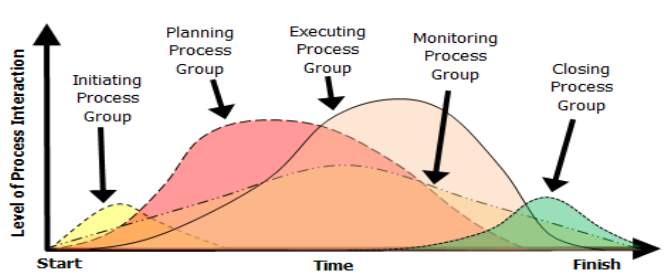
Fig 1.3 Project Life cycle execution [4]
1.4.4 Closing
This is the final phase of the project, also known as completion phase. In this phase the importance is given on releasing the final deliverables to the clients, handling over project documents to the business, dismissing supplier contracts, releasing project resources, and communicating the closure of the project to all stakeholders. The closeout phase a review of the project needs be conducted. The aim is to learn lessons from this job which can be applied to future projects. Two questions should be asked: “What did we do well?” and “What do we want to improve next time?” [4]
1.5 Management Function
Management functions have been classified by many experts. As per George & Jerry’s opinion planning, organizing, actuating and controlling are four most management functions. Whereas Henry Fayol explained management as, “To manage is to forecast and plan, to organize, to command, & to control. 3
Luther Gullick has given a word ’POSDCORB’ to describe management function. P = Planning, O = Organizing, S = Staffing, D = Directing, Co = Co-ordination, R = reporting and B= Budgeting. [3][4][5]
However management function given by KOONTZ and O’DONNEL are widely accepted i.e. Planning, Organizing, Staffing, Directing and Controlling.
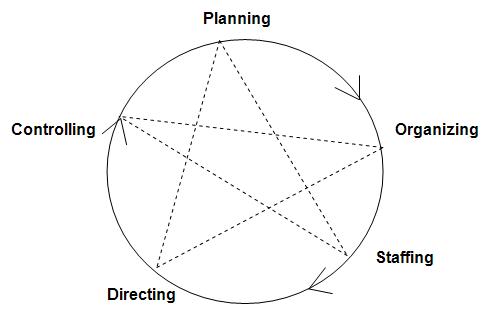
Fig 1.4 Project Management Quality Functions [6]
1.5.1 Planning
Most basic function for management has been considered as planning. In this phase, various future course of action is planned and decided in advance. Then the most suitable course of actions for achievement of pre-determined goals is selected. According to KOONTZ, Planning deals with 1) what to do? 2) When to do? 3) How to do? Planning is all about where we are at current time & where we want to be in future. So, plan is a future course of actions and planning is purpose of courses of action in order to achieve predetermined desired goals. Therefore, planning is a systematic thinking about various ways to achieve predetermined scope of work. Planning is an inevitable to make sure accurate utilization of resources (human & non-human). [4]
So in nutshell, Planning is all about problem solving and decision making. Planning is an intellectual activity which is beneficial for avoiding uncertainties, confusion, risks etc.
1.5.2 Organizing
It is the process of how to best arrange and utilize human and financial resources in order to accomplish predetermined goals and scope. According to Henry Fayol, “To organize a business is to provide it with everything useful or its functioning i.e. raw material, tools, capital and personnel’s”. Organizing process include following process: 1) Identification of important activities to be done 2) Classification of activities 3) Duties assignment 4) Creation of responsibility and responsibility relationships. [5][6]
1.5.3 Staffing
Staffing is all about selecting right man on right job. For various position, numerous types of people are required with quantified skills and qualification. Hiring deserved one is most vital thing as each and every one is essential in order to achieve goals and objective of project successfully. According to Kootz & O’Donell, “Managerial function of staffing involves manning the organization structure through proper and effective selection, appraisal & development of personnel to fill the roles designed the structure”.
Staffing involves Manpower Planning, Recruitment & Placement, training and development, remuneration, Performance Appraisal, Promotion and Transfer. [5][6]
1.5.4 Directing
It is that part of managerial function which actuates the organizational methods to work efficiently for achievement of organizational purposes. It is considered life-spark of the enterprise which sets it in motion the action of people because planning, organizing and staffing are the mere preparations for doing the work. Direction is that inert-personnel aspect of management which deals directly with influencing, guiding, supervising, motivating sub-ordinate for the achievement of organizational goals. Direction has following elements: [5] [6]
- Supervision
- Motivation
- Leadership
- Communication
Supervision - suggests overseeing the work of subordinates by their superiors. It is the act of viewing & directing work & workers.
Motivation - means inspiring, stimulating or encouraging the sub-ordinates with zeal to work. Positive, negative, monetary, non-monetary incentives may be used for this purpose. [5][6]
Leadership - could be defined as a procedure by which manager guides and influences the work of subordinates in desired direction.
Communication – is the process of transition of information, experience, opinion etc. between one another. It is a conduit for understanding information. [5][6]
1.5.5 Controlling
It recommends measurement of achievement against the standards and correction of deviation if anything to confirm attainment of administrative goals. Controlling measures are usually taken to preserve the standards of every occurrence. An efficient system of control benefits predicts deviations before they actually occur. According to Theo Haimann, “Regulatory is the process of inspection whether or not proper progress is being made towards the objectives and goals and acting if necessary, to correct any deviation”. According to Koontz & O’Donnell “Controlling is the measurement & correction of performance activities of subordinates in order to make sure that the enterprise objectives and plans desired to obtain them as being accomplished”. Therefore controlling has following steps: [5] [6]
- Establishment of standard performance.
- Measurement of actual performance.
- Comparison of actual performance with the standards and finding out deviation if any.
- Corrective action.
In order to achieve desired goals and objective certain set of rules and procedure is required to be followed. Here, some of the Project Functions are described below. [3][4]
CHAPTER TWO: Types of Project Audit
Different types of audits that is being used in construction industry are as follows: [9]
- Prequalification or Pre-selection Audits: – It reviews that the association or the Project is performing keeping in mind the end goal to evaluate the arrangement of a subcontractor or supplier (counting Designers) before an agreement is signed with them.
- Third-Party Audits for accreditation purposes: – This is the point at which an outsider authorize association is welcomed (“enlisted” essentially) to review a development extend keeping in mind the end goal to give the Certificate (commonly required by the Client).
- Project Internal Audits of the quality administration arrangement of the Project: these are normally performed by the quality staff of the particular Project (Quality or QA/QC Department) and they are pointing on examining the inward procedures that have been set up for this Project as it were. This class likewise incorporates Audits on Subcontractors and Designers.
- Specific Internal Audits from the parent organization: these are reviews that are performed by (normally) the Quality Department of the parent organization (Contractor or other). They are essentially pointing on observing the execution of the Project as indicated by the corporate strategies. These are extremely normal in Joint Ventures too, where each accomplice screens the project’s system and performance.
- Audits by the Client or Client’s agents (Project Managers): These are Audits asked for by the Client or Client’s delegates with the end goal for him to ensure that every legally binding prerequisite in regards to the quality administration arrangement of the Project is set up. More often than not amid the Audit, the Contractor is spoken to by the Project’s Quality Department. Development industry is one of the enterprises where the “client” has the opportunity to perform reviews amid the creation of the “item”.
- Internal “Small Audits”, “Observations” or “Works-Audits”: these are typically short reviews from the Quality Department of a Project to guarantee that the endorsed documentation (Method Statements, Inspection and Test Plan, Procedures and so on) are taken after on location. Once in a while these are additionally executed as “Quality Tours or Walks” and its normal these ones to be performed (or seen) by the Client’s delegates also.
- Other Audits: these are for the most part spontaneous reviews that the administration asks for after an occurrence. They can fundamentally have a place with any of the above classifications.
CHAPTER THREE: Overview of various project audit models
3.1 Portfolio, Program and Project Management Maturity Model (P3M3)
P3M3 is as of now offered by Axelos, a joint wander between the UK Government and Capita which assumed liability for materials in Jan 2014. Prior to this, Office of Government Business (OGC), a division within the UK Government claimed P3M3, which has driven piles of examination in the field of wander organization. The P3M3 is basically based on Capability Maturity Model Integration (CMMI) of Carnegie Mellon College and chips away at a similar technique. At to begin with, something like 1986 and 1991, the Software Engineering Institute (SEI) of Carnegie Mellon College made a primitive adjustment out of the model. Afterward, therefore of its deficiencies authorities improved it as the P3M3, which is considered when in doubt and an once-over of headings for undertaking any project and its administration, portfolio organization and program management. [8][9]
This model uses the ranges which are basic and contributes in holding the achievement of a venture. Exercises which are to be completed in the project and program levels in addition to within association are perceived by P3M3 model and assumes the liability to actualize them [9] .This can be utilized with numerous association sorts like private, open, advisor, and preparing and never concentrates on a particular industry. The model P3M3 recommends that project arranged association searches for basic venture prerequisites have been broken into two gatherings and they are Mature and Immature. There are reasonable and sufficient standard system and rules to keep the errand on the schedule and on a going through arrangement with a high gauge with regards to develop association, Managers screen and control the advance of the project against the project plan and reliable considers the partner’s satisfaction.
P3M3 concentrates on the accompanying seven Process Perspectives, which exist in every one of the three models and can be surveyed at all five Maturity Levels.[10]
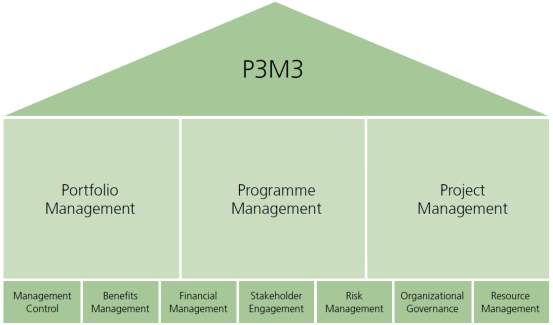
Figure 3.1.1 Management hierarchy structure [8]
3.1.1 Advantages of utilizing P3M3
It is essential for associations to comprehend the ideal level of execution in their mission to maximize value for money from investment, and to have a reasonable perspective of what they can accomplish. Not all associations will have the capacity to achieve the highest level and, for some, the centre levels might be satisfactory to meet their business needs and desires. To pick up the most extreme advantage from utilizing P3M3, execution change ought to be viewed as a long-term process (Figure), despite the fact that it is conceivable to accomplish short-term execution gains up by utilizing P3M3 to recognize and correct execution shortcomings. There are various reasons why associations might utilize a maturity model to survey their present execution, for example, [8] [9]
- Legitimizing interest in portfolio, program or venture administration changes.
- Gaining acknowledgment of administration quality keeping in mind the end goal to support proposals.
- Gaining a superior comprehension of their qualities and shortcomings with a specific end goal to authorise change to happen.
P3M3 uses a five-level maturity framework and the five Maturity Levels are:
Level 1 – awareness of process
Level 2 – repeatable process
Level 3 – defined process
Level 4 – managed process
Level 5 – optimized process
Table 3.1.1 Five Levels P3M3 model [9]
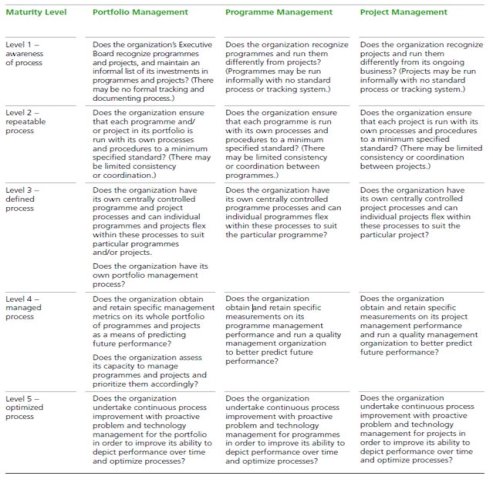
3.1.2. Maturity Level Explanation
Level 1 – Awareness of process
Procedures are not normally reported. There are no, or just a couple, prepare descriptions. They will generally be recognized, in that administrators may have some acknowledgment of the vital activities, yet genuine practice is controlled by events or individual inclinations, and is exceptionally subjective and variable. Procedures are in this manner undeveloped, in spite of the fact that there might be a general duty to process advancement later on.
Undeveloped or inadequate procedures imply that the essential activities for better practice are either not performed at all or are just halfway performed. There will be nearly nothing, assuming any, direction or supporting documentation, and even phrasing may not be institutionalized over the association – e.g. business case, chance, issues, and so forth may not be deciphered similarly by all supervisors and colleagues.
Level 1 associations may have accomplished various fruitful activities, yet these are regularly in light of key people’s abilities instead of organization wide information and capacity. Also, such “successes” are regularly accomplished with spending plan or potentially plan overwhelms and, because of the absence of custom, Level 1 associations frequently over-confer themselves, desert forms amid an emergency, and can’t rehash past triumphs reliably. There is next to no arranging and official purchase in, and prepare acknowledgment is limited. [7][8]
Level 2 – Repeatable process
The association will have the capacity to illustrate, by reference to specific activities, that basic management have been established – e.g. following expenditure and scheduling resources – and that procedures are developing. There are key people who can show a fruitful reputation and that, through them, the association is equipped for repeating prior accomplishments later on.
Process discipline is probably not going to be thorough, however where it exists, activities are performed and overseen as indicated by their reported arrangements, e.g. project status and conveyance will be unmistakable to management at characterized focuses, for example, on achieving significant milestones.
Best management will lead the pack on some of the activities yet there might be irregularity in the levels of engagement and execution. [10]
Essential generic training is probably going to have been conveyed to key staff. There is as yet a noteworthy danger of surpassing expense what’s more, time appraisals. Key elements that may have preconditioned the association to experience challenges or disappointment include: insufficient measures of accomplishment; indistinct duties regarding accomplishment; uncertainty and irregularity in business targets; absence of completely incorporated hazard administration; limited experience in change management; and deficiencies in communications strategy. [10]
Level 3 – Defined process
The management and specialized procedures important to accomplish the hierarchical reason will be reported, institutionalized and incorporated to some degree with different business forms. There is probably going to be process ownership and a built-up process gather with duty regarding keeping up consistency and process enhancements over the association. Such upgrades will be arranged and controlled, maybe in light of assessments, with arranged improvement and appropriate resources being resolved to guarantee that they are composed over the association.
Best management are locked in reliably and give dynamic and informed support. There is probably going to be a set up preparing system to build up the abilities and information of people so they can all the more promptly play out their assigned parts. A key part of value administration will be the boundless utilization of companion audits of recognized items, to better see how procedures can be enhanced and accordingly kill conceivable shortcomings.
A key qualification between Level 2 and Level 3 is the extent of measures, process depictions and techniques – i.e. expressed purposes, inputs, activities, roles, check steps, yields and acknowledgment criteria. This empowers procedures to be overseen all the more proactively utilizing a comprehension of the interrelationships and measures of the procedure and items. These standard procedures can be customized to suit particular conditions, in understanding with rules.
Level 4 – Managed process
Level 4 is described by develop conduct and procedures that are quantitatively overseen – i.e. controlled utilizing measurements and quantitative procedures. There will be proof of quantitative targets for quality and process execution, and these will be utilized as criteria in managing processes. The estimation information gathered will contribute towards the association’s general execution estimation structure and will be basic in breaking down the portfolio and determining the present limit and capability constraints.
Best administration will be submitted, drawn in and proactively searching out inventive approaches to accomplish objectives.
Utilizing process measurements, management can viably control forms and recognize approaches to alter and adjust them to specific activities without loss of quality. Associations will likewise profit through enhanced consistency of process execution.
Level 5 – Optimized process
The association will concentrate on streamlining of its quantitatively managed procedures to consider changing business needs and outside variables. It will expect future limit requests and ability prerequisites to meet conveyance challenges – e.g. through portfolio investigation.
Best mangers are viewed as models, strengthening the need and potential for ability and performance improvement.
It will be a learning association, propagating the lessons gained from past audits. The association’s capacity to quickly react to changes and openings will be upgraded by distinguishing approaches to quicken what’s more, share realizing.
The information picked up by the association from its procedure and item measurements will empower it to comprehend reasons for variety and thus upgrade its performance. The association will have the capacity to demonstrate that consistent procedure change is being empowered by quantitative criticism from its implanted procedures and from approving imaginative thoughts and advances. There will be a strong structure tending to issues of government, organizational controls and execution administration. The association will have the capacity to exhibit solid arrangement of hierarchical goals with strategies for success, and this will be fell down through perusing, sponsorship, duty, arranging, asset assignment, chance administration and advantages acknowledgment.
3.2 Prince2 Maturity Model (P2MM)
This model has a place with the UK Office of Government Commerce (OGC) and can be meant as P2MM. This model empowers associations and companies to evaluate their development when utilizing the PRINCE 2 Project Management Method which was made by a similar office in 1989. Truth be told, numerous eminent organizations have utilized the PRINCE2 as a project management technique with a specific end goal to enhance its execution. Axelos [1-4] has many papers that were distributed portraying the implementation of the strategy for the accompanying associations: Konica Minolta Business Solutions Europe GmbH, Scheidt and Bachmann GmbH, US Federal Government IT Projects, GDF SUEZ E&P UK. [11]
Moreover, the PRINCE2 Maturity Model is gotten from the Portfolio, Program and Project Management Maturity Model (P3M3). Thus, they have a similar structure. In this way, the Prince 2 Maturity Model uses the five development levels that can be delegated the accompanying: –
- Awareness of process
- Iterating process
- Defined Process
- Organized Process
- Optimized Process
The question which emerges is how to assess each maturity level? Axelos has distributed a report which speaks to a decent reaction to the past question:
Maturity Level Evaluation
Level 1: – Has the association perceived tasks and has an alternate method for directing them?
Level 2: – Does the association receives the PRINCE2 Method and applies it to all ventures so that there a repeatable procedure?
Level 3: – Is there an adjustment of the PRINCE2 technique to fit the necessities of various tasks?
Level 4: – Is the association fit for directing estimations of the execution of the project management and deals with its quality so as to show signs of improvement future execution forecast?
Level 5: – Does the association direct ceaseless upgrades of procedures so it can assess its current and improve future execution?
Likewise, this model concentrates on seven procedures that traverse over the key components of the associations extend administration strategy. These procedures can be evaluated at any level of development. They can be displayed as the accompanying: [9] [10]
- Financial Management
- Benefits Management
- Management Control
- Stakeholder Engagement
- Risk Management
- Organizational Governance
- Resource Management
An arrangement of the past procedures will be further created to give a thought on the content of each procedure. Additionally, it will give rules when separating and surveying their level of maturity. [10][11]
For the Financial Management, this procedure guarantees that the expenses are assessed and after that oversaw over the venture time frame. Additionally, the money related Management will consider the presence of assets to secure the speculations without overlooking the conjecture of the diverse activities that can prompt distinctive advantages.
Moreover, the Risk Management is a key business handle in this model. It bargains for the most part with the open doors and vulnerabilities contained in each venture. It has as on goal the improvement of various systems beat diminish the likelihood of vulnerabilities to happen. There ought to be sufficient proof that moves are made to deal with the dangers.
Also, the Resource Management is tended to through this model. Indeed, this procedure addresses the management parts of various sort of material and HR. The procedure assesses whether the association successfully utilizes its assets to accomplish its goals.
Similarly, the Stakeholder Engagement procedures is explored in this model. For the most part, an examination of the inner and outside partners is directed to decide their level of support and engagement. The correspondence channels speak to one of the engagement parts of the stakeholders.
In what concerns the Organizational Governance, it bargains for the most part with the conveyance of the activities in association with the organization strategies.
In addition, it ought to be highlighted that the formal appraisal ought to be finished by PRINCE2 Registered Consultant (P2RC) as laid out by the official site of PRINCE2. There are numerous associations that offer accreditations to specialists and are essentially spoken to by the Association for Project Management (APM) in the UK and the American Society for the Advancement of Project Management in the USA.
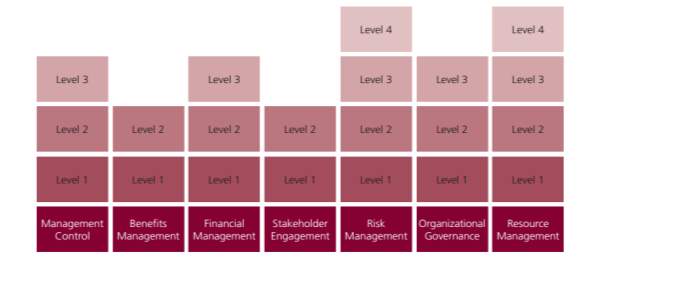
This model can be utilized as a legitimization to put resources into project management upgrades. Likewise, it’s a gauge to mirror the purposes of qualities and insufficiencies so steps can be taken to enhance the method for overseeing projects. Also, it’s an approach to secure a level acknowledgment for future customers.
The appraisal itself is one milestone during the time spent enhancing the execution. The structure of P2MM is a capable device that licenses to associations to decide their current circumstance. What’s more, it gives a general vision of the procedures that interpret the project management capacities of the association. At that point, contingent upon the level that the association needs to achieve, arrangements can be custom-made to address inefficiencies and enhance the level of execution beginning from the evaluation. It is helpful to express that not each association needs to achieve the level 5 yet the result relies on upon the level of execution focused on and that can suit its needs.
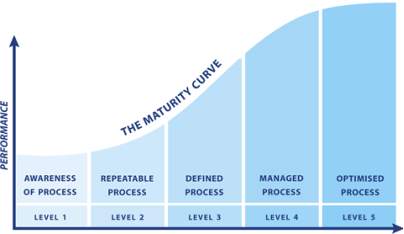
Figure: 3.2.2 An example of long term performance [9]
Likewise, push that organizations with a low level of maturity put their projects at enormous dangers that lead all the time to indirect expenses. [10]
3.3. EFQM Excellence Model
EFQM is abbreviated for European Foundation for Quality Management (EFQM). This model is very crucial in any organization’s development with respect to engagement of public & private sector to each area of association. Excellence model is globally recognized as a standard model for project or organization improvement due to its flexibility and high excellence level. According to the report of European standard this model encompasses three basic yet essential components. [12][13]
3.3.1 Fundamental concepts of excellence
Excellence for any organization comprised standards and quality achieved to elaborate high Excellency level of work/project. This distinction in work or project can proclaim further proficiency towards various public users and stakeholders. Fundamental of excellence can be given to describe various attributes of organizational structure. There are several fundamental components for excellence given below. This concepts are required to fulfil various needs of superiority in project results. [14]
- Adding value to customers
- Creating sustainable future
- Developing organizational capabilities
- Connecting creativity & Innovation
- Leading with vision, inspiration and, integrity.
- Sustaining outstanding results
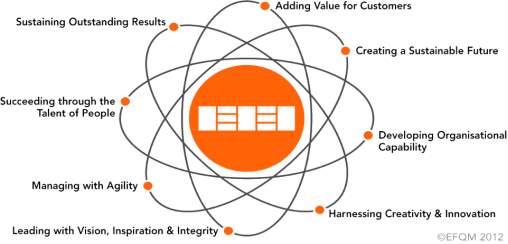
Figure 3.3.1 Concepts of Excellence [11]
3.3.2 The Criteria
The second phase of the EFQM is designated to various criteria. This section is very essential as it serves the basics of organizational leadership & strategic planning. According to the European union report, any organization or project leader need to develop their people, partnership and processes to deliver essential outcome to their customers. There are two features includes in the section to enables varied improvement in one organizational work. Enablers and Result are two foremost factors to evaluate the project work quality along with its process and people. [13][14]
Enablers: These are the important strategies one organization’s need to accomplish to achieve certain outcomes. Enablers are very essential elements for the strategic planning and development phase of the organization. There are mainly five enablers in the EFQM model. Enablers are responsible for several aspects in the organizational development. For instance, leader is crucial element to shape various future happenings and adding ethics and values to their work, while people are important to gather together to accomplish various association goals with ethical values. People are also responsible to add their considerable efforts to fulfill their organization needs with its Excellency standards. Strategies are important with client perspective as customers or stake holder of organization are in various needs to seek extraordinary work from the association. It is important for organization to manage plans, policies, objective and processes to deliver customary strategy. Partnership, resources, product and services are effortlessly important in many organizational relations and external partnership. [15]
- Leadership
- Strategy
- People
- Partnership & Resources
- Processes, Product & Service
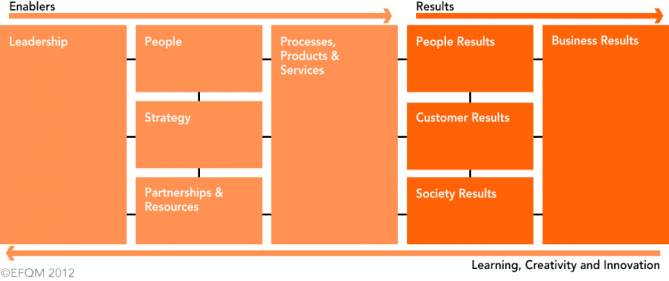
Figure 3.3.2 Criterion [11]
Results Criterion: Result criterion are shown on the right side of the model given in the figure 6.2.These four result criterion are very important to consider for ensuring various organizational Excellency. There are various strategic goals acquired in this stage of model. [13]
- Setting appropriate targets for certain results groups, based on varied needs and expectations of relevant customers is one of the key aspect in this criterion.
- Segmentation of various results to refine the performance of various areas in the organizations along with expectations, and needs of stakeholders is second key feature.
- Sustainable and positive demonstration of business results at every three year period.
- Understanding various reasons for failure and lake of consistency in results are essential in this phase.
- Developing set of key indicators and related outcomes to regulate successful disposition in strategy of the organization.
Four results criterion are given here
- Customer results
- People results
- Business results
- Society results
3.3.3 The RADAR
RADAR is logical framework for dynamic assessment as it consider as powerful management tool to provides a questioning the performance of organization. RADAR system consists four major features to evaluate organization performance. [14][15]
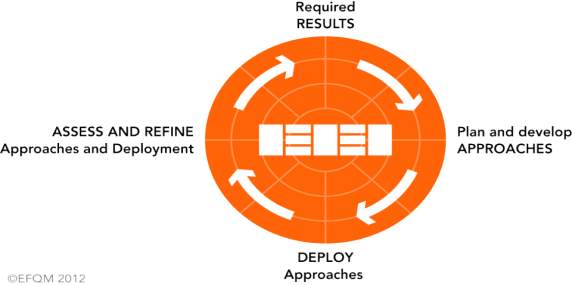
Figure 3.3.3 RADAR [11]
RADAR exemplify various attributes to be fulfilled by an organization. [14]
- Result determination is proposedly consider as part of strategy to achieve any goal.
- Approaches related to planning and developing are integrated to deliver the appropriate results for present and future requirements.
- Deployment of various approaches in systematic way to ensure certain implementations.
- Assessment and Refinement of deployed approaches based on analysis of results achieved.
RADAR can be essentially useful to rationalize various level of work in the organization along with the assessment for present and future requirement.
3.3.4 EFQM model applications and implementation
There are various assessment features can be described through this models to analyze current capabilities and performance along with future outcomes. Various implementation steps acquired to model given here [15] [16]
- Engagement of various level of team members into project for better implementation
- Planning phase to be determined for entire project phase with the consideration of each team member
- Appropriate training and information to each participant.
- Development of action plan with the various strategic assessment planning
- Evaluation after the result achievement.
3.3.5 Potential benefits of Model
- Excellence model carries holistic framework to address systematic approach for varied range of quality issues in organizations along with addressing impact through result criteria.
- Continuous improvement approach is potential asset for this model.
- Diagnosis of organization activities is considerable useful to achieve various goals with appropriate resources used by an organizations.
- This model denies any external validation requirement as it can be useful as self-assessment tool for the valuation of its activities.
- Scoring system in the model can issued as internal benchmark for the model to use as assessment. This scoring system can also be useful to benchmark and compare some external organizations.
- It mainly focused on weak area of organization and to provide adequate help to achieve appropriate strength along with other area of the association.
3.3.6 Limitations of the model
- Scoring and award recognition schemes in the model can be expensive for smaller enterprise use.
- This is formally not recognizable model to various customers due to lake of any formal mark.
- EFQM was initially developed for only few commercial uses which hinder it to translate in other languages.
3.4 OHSM( Occupational Health & Safety Management) System Model
There are numerous important aspects such as plan, implementation, evaluation, and continues progress covered in OHSM model. OHSM is abbreviated for Occupational Health & Safety Management system. This model is deliberately focuses on ongoing health and safety concerns along with various elements align with future needs for improvement. Initially the model was proposed to concern various technical issues which later reformed to focus on human behavioral factors along with organizational cultural issues. There are some crucian management systems included in the model. [16][17]
- It consists all components of occupational safety t health which is mostly relevant to members and related business.
- Principally its functions are:
- Proliferate effectiveness of management system of model.
- Compliance with existing legislation to comply with law.
- Various features such as ethical, economic, legal and organizational goals are included to define various objective of the model.
- Holistic approach is covered to implement of various elements and to provide interaction in organization.
- Outputs in the model approach is considered as evaluation tool for management system.
This model is considerably focuses the various health and safety issues at workplace. Some basic requirement for the model to implement in any project are given here. [17]
- Identification and examination of health and safety hazards at work place.
- Various control measures requirement to eliminate or reduce hazardous risk to workers.
- Policy and management commitments should be clearly demonstrate in written form.
- Worker competency, training and inspection programs are required to have at each work place.
- Incident reporting, investigation and emergency response planning.
3.4.1 Advantages of OHMS model
There are numerous benefits of applying this model for health and safety management in the organizations. [17][18]
- Health and safety management system can apply awareness and help to improve belief of workers towards organizations which help to improve their performance & participation.
- It has been nominated as very effective and useful model to decrease overall injuries and hazards at the workplace.
- Occupying workers friendly behavior and pretense them a positive manners could be served through the implementation of this model.
- There has been several cost incursion reduction seen due to injuries and illness in workers after this model.
- This model can be beneficial to demonstrate acquiescence to customer and suppliers.
- Various health related cost and downtime has been decreased after intervention of this model in the systems/ organization.
There are some implications seen during the certification process or due to lake of standards. These weaknesses are described below in certification of OSH management system. [16]
Certification is a process to add extra quality to OSH management system, as audit of the system usually ensure compliance and focus on improvement. Traditional management system has also noticed some biased along in the system to identify deviation and solution for ongoing issues found in the structure.
There are some success factors for the model are given below here. This success factors are mostly based on the criterion and various needs for the organization for achieving success of model. [17]
- Better research and appropriate background information can be useful to avoid cross sectional method and further implementation could be done to comparison group.
- Number of control groups, cofounders measurement and adjustment of statistics can give proliferation in success rate of model.
- Application of rigorous methods for sampling along with sample data collection can give god results.
- Various considerations for cash flow and implementation of rigorous methods for economic evaluation can give desire results from the model.
- Effectiveness can also be amplified through application of larger sampling group rather than using solitary work place studies.
3.5 Kerzner Project Management Maturity Model (KPM3)
Strategic project planning and other phenomenon for successful project has been recognized from several decades. Harold kerzner has invented project management model innumerably knows as Kerzner project management maturity model. This model is thoroughly possessed acquisition to best strategic management plans for any organization. Additionally this model is excellent medium to gain such Excellency in project management system of any organization. Kerzner notifies that this model is considerably fruitful for strategic and multilevel planning for any organization. [19]
Foundation of achieving superiority level in various strategic goals can be illustrated by maturity model of Harold Kerzner. This model consist five basic level to enable better understanding of its functionality and proficiency for project management. Given fig. 6.5.1. This levels are commonly known as level of common language, common process, singular methodology, benchmarking, and continuous improvement. [19]
Process Improvement
Level 5: Continues Improvement

Process Control
Level 4: Benchmarking


Process Definition
Level 3: Singular Methodology
Basic Knowledge

Level 2: Common Processes
Level 1: Common Language
Fig.3.4.1 Five Levels of Project maturity model. [18]
Level 1: Common Language
This phase of model consists various understandings of terminologies relating to project management strategies. This level of model complies various strategic considerations with prior information about further progresses. [18][19]
Level 2: Common Processes
This level possess the adaption of various process prom previous successful project. This level define various methodologies and management principles for adaption in organizational planning. This common processes are basically based on application, planning and strategies of project to fulfill organization needs.
Level 3: Singular methodology
In this level organization combines all corporate methodologies with recognition of synergistic effects to convert into one singular methodology. This process gives certain methodology to organization to proceed in the project. Organization can achieve various benefits of synergistic effect from combining all methodologies from various corporate groups.
Level 4: Benchmarking
Benchmarking level is to provide competitive advantage environment for organization to improve continuously. This level define various benchmarks and reasons behind selecting certain benchmarks.
Level 5: Continuous Improvement
This level summarized the details from benchmarking level to enhance the further improvement in the project. This level also calibrate various methodology information for decision about further improvement in the project.
Maturity model can assign Risk factor to each level with various studies. This risk factors are designated in three level as low, medium and high respectively. The level of risk is accompanying the influence (alteration) on the corporate culture. The risks can be termed as follows: [7]
Low risk: This level of risk does not impact on the corporate culture. Low level of risks are culturally acceptable as it is dynamically less affective.
Medium risk: Various change factors and other considerations related to unfavorable yet decisive alteration in an organization can be termed as medium level risk.
High risk: The type of risk which can be alter ultimate structure of corporate level then it can be nominated as high level risk.
Advantages of Maturity Model: [18]
- This model is certainly flexible and broad to implement in any type of organizational structure.
- It consists decisive and organized steps to evolve various management planning.
- This model is thoroughly easy and effective to implement and understand in real life practice.
Limitations of Maturity model: [18]
- Maturity level planning is considerably lake in the model hence it is impair to guide organization in several critical directions.
- It is generic model which can be limitation for complex projects and also not useful in complex strategic management.
- Project maturity model is very helpful in basic strategic policy planning hence it is not useful in directive and overall organization policy planning.
3.6 People Capability Maturity Model (P-CMM)
Capability to ensure worthwhile use of present workforce in any organization is crucial task. Capability of people in organization are essentially a direct need to any organization’s development. The concern about improving workforce quality to ensure better development at organization is widely discussed. People capability maturity model is depicts the various phase to ensure workforce growth in the organizations, along with quality management of workforce, credibility planning and future growth analysis. There are mainly five phases discussed in this model to ensure development of workforce. [22]
This model also helps making decision about strategic planning in the organization mainly focused on the workforce development. [21] The five levels of people maturity model is considerably effective to describe its applications, effectiveness and Excellency. This model has been widely recognized in many computer system organizations as it has made exceptional change in their workforce quality and efficiency. Five levels are given here.
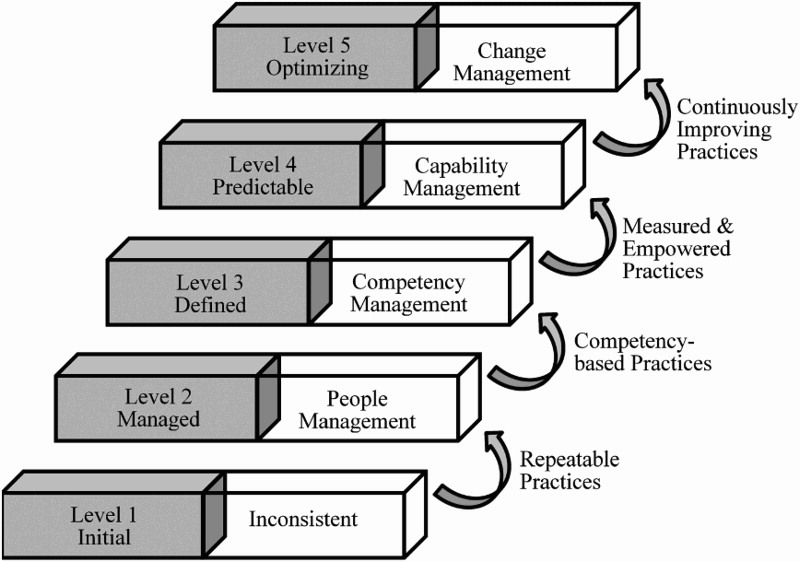
Figure 3.6.1 Levels of people capability maturity model [19]
Five levels for people capability maturity models are given below here. Fig 6.6.1 illustrates brief description of each level. [21]
Level 1: Initial
This level is proportionally left undesignated as it is considered as initial or starting point for the model. Initial level is prior level for people capability maturity model.
Level 2: Managed
Level two of the model is very essential yet prior phase for human resource management in the organization. There are several conjugates partitioned in this level to accommodate the management of workforce. Staffing, communication & Coordination, work environment, performance management, training & development are several parts of this level. Fig. 6.6.2 shows the various level configuration for people capability maturity model.
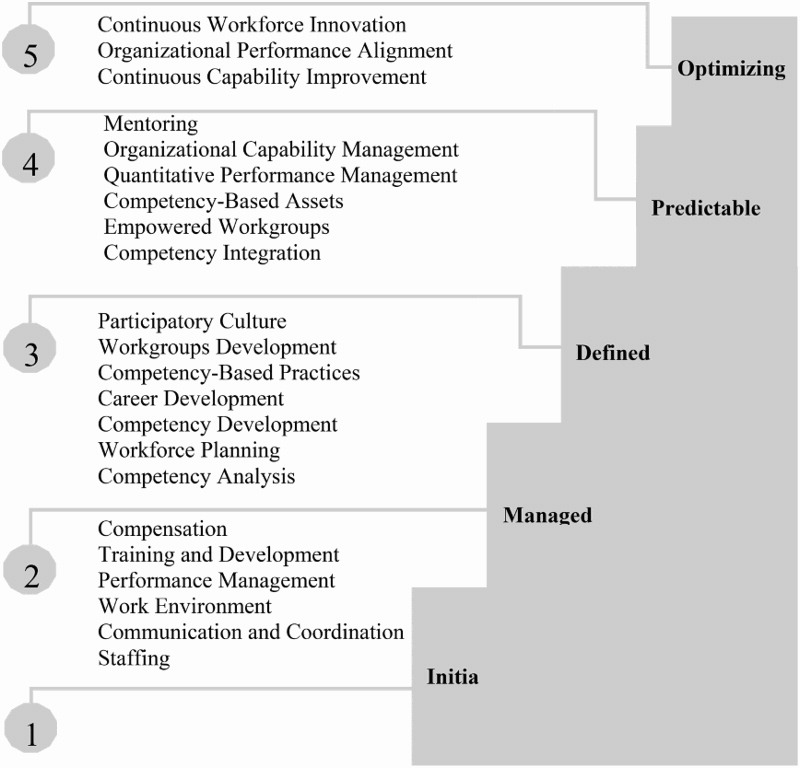
Figure 3.6.2 Levels Descriptions for People capability model [19]
Level 3: Defined
Define level is secondary phase which contains various analysis and development model for workforce. This level has subsidiary planning for various department such as competency-based practices, career development, and participatory culture along with development of wok environment. [19][20]
Level 4: Predictable
Organizing capability model, future planning, mentoring, workgroup empowerment are various phases in predictable level of this model. Level three progression and calibrated planning from previous level has useful impact on predictable phase work.
Level 5: Optimizing
Final phase of the model is well defined for optimization of all previous phase. This level contains various improvement and optimization techniques along with continuous workforce innovation, capability innovation. This level is very essential in the model as it defines future innovation goals and preparation.
Benefits of People Capacity maturity model:
- This model abide robust methodology to conduct various planning phases. This approach is very important factor in this model’s success.
- There has been various other model standards considered while designing this model which gives several benefits towards lack and inconsistences revealed in other models. [22]
- This model is also very flexible and appropriate to any type of industries.
Limitations of model:
- Complexity of this model has few limitations to understand its overall procedure. Lengthy and tedious processes also makes this model monotonous.
- Several aspects of the model has designated high risk and also proven vulnerable to some critical situations.
3.7 Organizational Project Management Maturity Model
The Project Management Institute (PMI) published a standard called The Organizational Project Management Maturity Model (OPM3) under the stewardship. For Organizations, the main purpose of the OPM3 standard is to presents an approach to explain an organizational project management and to assess the maturity of the project against a broad-based set of Organizational project management best practices.
3.7.1 Definition: Organizational Project Management[21]
Organizational Project Management is used to achieve or complete the goals of the Organization by means of projects. Organizational project management is the utilization of skills, techniques, knowledge, and tools to project and organizational activities. In OPM3, the term “Organization” is not limited to an agency, company or society but it applies to a group which is aiming to use their material in the OPM3 standard. It illustrates business strategies and gives regulations and high-level perspective of resources which straightly influence financial consequences of organizations if it is used properly. Overall, OPM is a strategic asset in a competitive economy.
3.7.2 Organizational Maturity[21]
In the case of Organizational Project Management, the “maturity model” is a conceptual network which contains constituent parts that characterize maturity in the area of interest. With the use of OPM3, the maturity model also gives a process which can establish a set of best practices and capabilities. This process makes the organizational state more mature thus it gives the more mature organization. Organizational project management maturity is demonstrated by the consolidation of the best practices within the program, projects and portfolio domains.
The incremental effectiveness that accumulated to best practices is described in the maturity model of OPM, which are also essential to powerful organizational project management. There are several ways and dimensions to assess the organization’s maturity and the progress of increasing maturity using the OPM3. One of these dimensions comprises looking best practices in terms of the cooperation with the progressive stages of process improvement. This process improvement is from standardization to control to measurement which leads to the continuous improvement of the projects of an organization. As shown Figure 1, the maturity of the organizational project management is increasing along a continuum. The progression of the best practices connected with each of the domains is included in another dimension. This dimension firstly addresses project management, then program management and finally portfolio management[21].
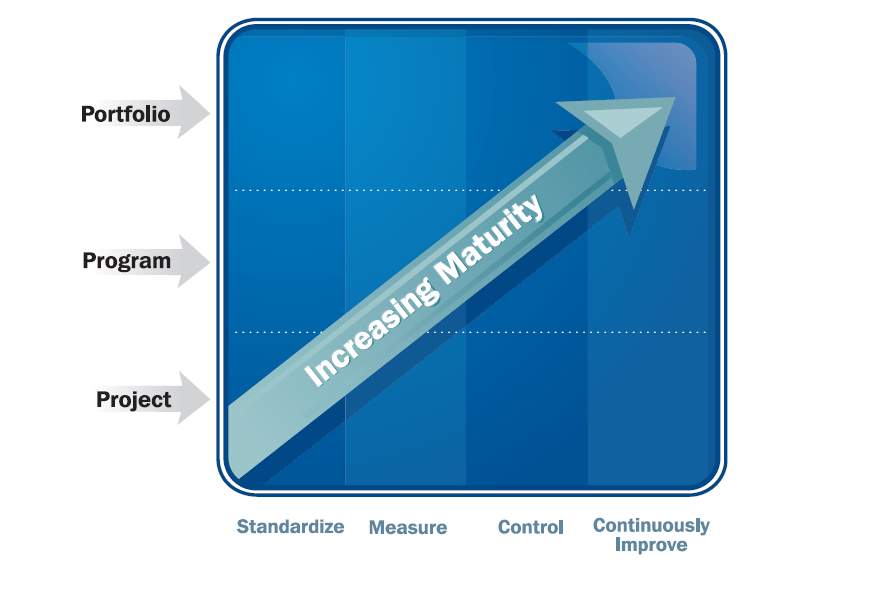
Figure 3.7.1 Organizational Project Management Maturity[21]
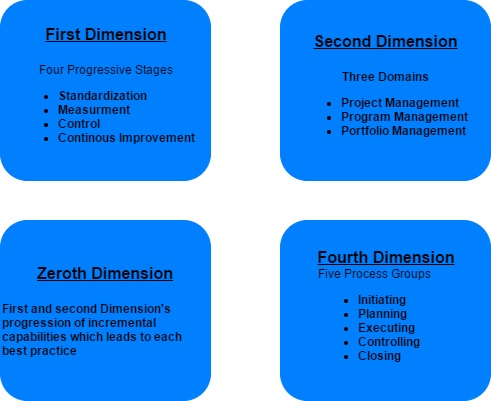
Figure 3.7.2 Dimensions of the OPM3 [22]
Organizational project management maturity model is intentionally developed without any overall system of levels of maturity. If the maturity progress is one dimensional, the development of the specific maturity levels is very straight forward. However, OPM3 is a multi-dimensional. Furthermore, It categorizes the capabilities with their combination with five process groups of the project management. Initiating, Planning, Executing, Controlling, and closing are these process groups which permits the determination of the fourth dimension of maturity.
3.7.3 Elements of the OPM3
There are three interlocking elements of the organizational project management maturity model: Knowledge, Assessment, and Improvement. The user or an organization becomes capable in standards in the knowledge element. It includes the idea of OPM, organizational project management maturity, and methods and concepts of OPM3 to be comfortable with the body of the best practices. In assessment model, it is in a comparison with the standards to find the current place on the continuum of OPM maturity. Finally, in Improvement element, the decision to move forward with some changed initiatives gives increased maturity which can use these results of the assessment for planning and implementation of this plan. Figure 3 shows the interlocking of the elements of OPM3 with the concept in support of each element.
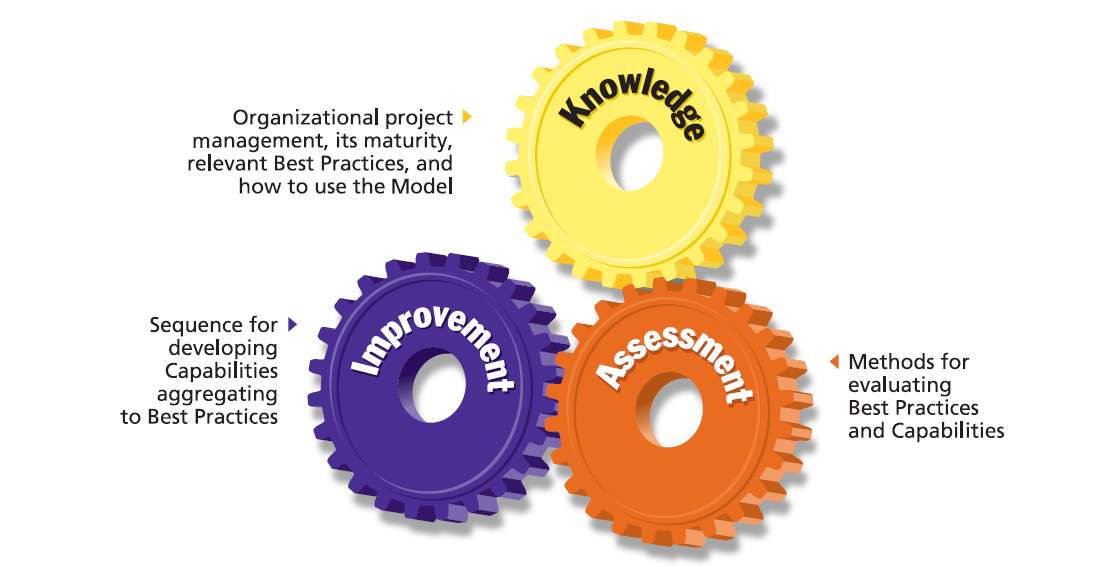
Figure 3.7.3 Interlocking Nature of the OPM3 Standard[21]
3.7.4 OPM3 Steps[21]
The following steps are related with the Knowledge, Assessments and Improvement Concepts.
3.7.4.1Knowledge
Step 1: Prepare for Assessment
The preparation for the process of assessing the maturity of the organization in relation to the model is the first step for an organization. This preparation includes the thorough understanding the contents of the model, with the operation of the organizational project management maturity model, and becoming aware of the organizational project management.
3.7.4.2 Assessment
Step 2: Perform Assessment
The second step is determining the organization’s maturity in Organizational project management. The comparison of the characteristics of the present maturity state of the model with the characteristics describes in the OPM3. This step includes the review of which best practices are included and are not included in the organization and establish its location on the continuum. Organizations can make their own assessment tool or they can use the tool provided in OPM3. Afterward, the further investigation of the capabilities of the organization is proceeded to in more details to find out the deficiencies which provide the plan of the improvement, repetition of assessment or exit the process as shown in figure 4.
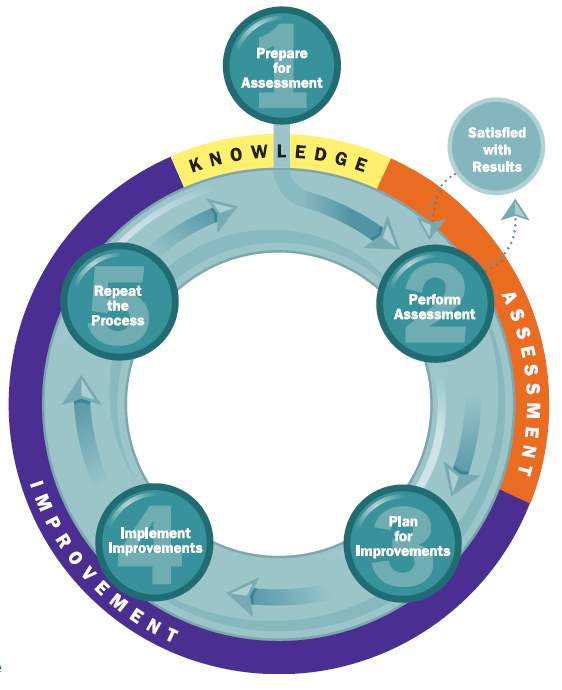
Figure 3.7.4 The OPM3 Cycle with Steps[21]
3.7.4.3 Improvement[22]
Step 3: Plan for Improvement
To improve the maturity if an organization, the results of the step two will produce the plan of the improvement. This step will rank the required capabilities and outcomes regarding their priority which can give an idea to develop a definite plan to improve and achieve the outcomes related to the capabilities of the best practices.
Step 4: Implement Improvement
The change or modification will take place in this step. The Organization will implement the plan once it is established in the previous step such as execute development activities to achieve the required capabilities and to increase the overall maturity of the Organization.
Step 5: Repeat the process
After completing the improvement activity, the organization will return to the step two to reassess the position of the organization on the continuum of the OPM maturity. Or else, It will return to the improvement step to address other best practices which were identified previously in assessment.
3.8 Roland Gareis Model
For Managing the projects, project portfolios and programs, Companies with project orientation have particular strategies, organizational structures, and certain cultures. The management of the programs and project provides competitive improvement for the social systems. Therefore, the organizations including nations, regions, industries are becoming more project oriented. There is an interrelationship between the outcomes of the project oriented systems in the project and their maturity state. These maturities of the project or an organization can be evaluated by different maturity models. In this section of the learning module, the maturity model developed by the ROLAND GAREIS Management of the project-oriented Company® has been discussed.[25]
Dr. Roland is a university professor at the Vienna University of Economics and Business Administration, Austria. Project Maturity models have different dimensions which relate to each other. ROLAND GAREIS model contains eight dimensions. These dimensions are discussed bellow.[23]
Project Management: A project is a defined as a provisional organization for the efficiency of the relatively short-medium, unique term, strategically crucial process of a medium or large scope. Project co-ordination, project controlling, project start, addressing project discontinuity and the project closedown are the sub-processes of this Important process.
Program Management: The function of the program management is the achieving the unique business process with considerable scope. Sub-sections of this are program co-ordination, program start, program controlling, program close-down and solving the discontinuity of the program.
Assurance of the Management Quality of a project: In order to secure the quality of the project, management auditing and management consulting is required.
Assignment of a project: The decision of whether project is to be achieved is employed will be performed in this dimension.
Project Porfolio Management: The decision of the project starting or abandoning, Project priorities are confirmed, allotment of the external and internal resources is contrived.
Personnel Management: The dis-position, recruiting and continuous improvement of project personnel such as owner, project manager, project team members, project contributor are consisted in this process.
Organizational Design: Organizational design consist of a formation or establishment of a project management office, a project portfolio group, the improvement of the project procedures and defined project plans.
Business Process Management in the project oriented Company: The process of this dimension is a designated sequence of activities. Different roles of one or more organizations are involved in this dimension. [24]
74 questions and 35 sub-criteria are included in Roland’s model. These sub-criteria have the same weightage and the main criteria has different weights regarding their importance. As shown in Figure 5, each dimension has the points between 0-100.
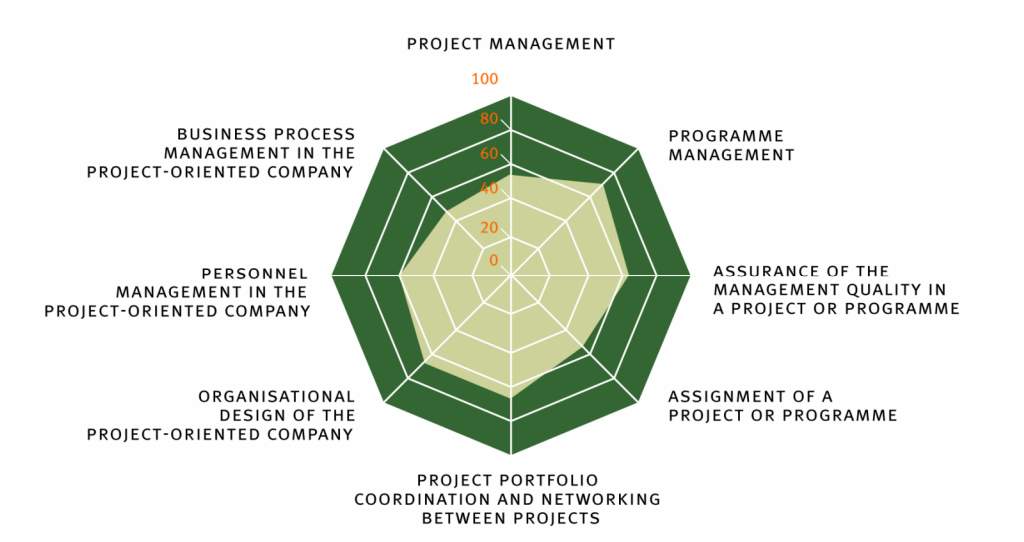
Figure 3.8.1 ROLAND GAREIS Model[25]
3.8.1 Project Management Competence[25]
To describe and determine the maturity of the project or an organization, the traditional maturity models use five steps. Project Management competence (PM-competence) is a capability to execute the process of the project management professionally. PM competence needs both the project management knowledge and the project management experience. According to the SEI Capability maturity model, the scales used are initial, repeatable, defined, managed and optimized as shown in Table 1.
The spider web presentation is a multi-dimensional presentation of the PM competence which allows a visualization of the different maturities of the project management sub process. Figure 6 demonstrates the spider web presentation of the organizational PM competence.
Table 3.8.1 Maturity level of the SEI model[25]
| Scale | Maturity Level | Description of Level |
| 5 | Optimized |
|
| 4 | Managed |
|
| 3 | Defined |
|
| 2 | Repeatable |
|
| 1 | Initial |
|
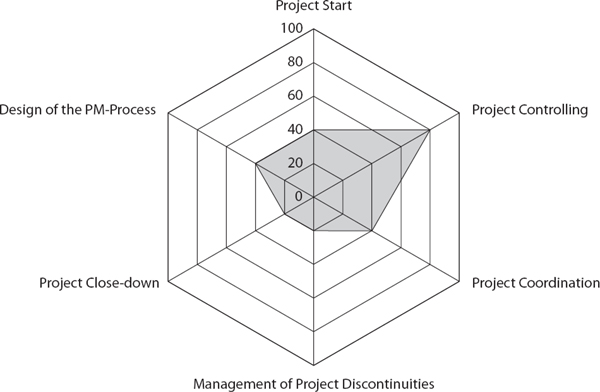
Figure 3.8.2 Web presentation of the project oriented organization[24]
3.8.3 Advantages of Roland Gareis Model[25] [26]
- Roland Gareis model is a multi-dimensional maturity model which focuses on the different aspects of an organization.
- It uses the spider web presentation which gives a visualised presentation of the project or an organization. This also presents the sub-models assessment.
- In order to determine the project management competence, it uses the set of the questions which is called questionnaire.
- Given graphical presentation of the spider web will also identify the issues which needs to be addressed to increase the maturity of the organization.
3.8.4 Disadvantages of Roland Gareis Model[25] [26]
- The Roland Gareis model is not compatible with the project life cycle because life cycle includes each process from the start of the project to its completion.
- It has a limited application and it can not be applied to each stages of the project.
- Projects gets isolated, the project team can cooperate with each other properly but when it comes to the different teams there is a lack of coordination.
3.9 Lynn Crawford Maturity Model
This model was established and presented by Human Systems Company in 2005 and named after the Professor Lynn Crawford. Her model reflects assessment of project mainly on three assessment tools, from which two are based on the project work scope and the odd one on organizational setup. “Project Health Check Tool (PHT)” and “Measuring Project Performance Tool (MPP).” Focuses on the projects and for organizations, it contains the “Practice Questionnaire Corporate (PQC).” The PHT does not conclude much information about maturity levels, the improvement cycle, sub-criteria, and evaluation questionnaires’’. There is no proper information on maturity levels, number of questions, and scoring system for this model and only it describes that the model evaluates the project’s maturity in 25 main criterions which are taken into account as listed in the table below: [21][22]
Table 3.9.1 Maturity criterion
|
Human Resource |
Cost Control |
Time-Planning |
|
Communication |
Quality Control |
Change Control |
|
Planning |
Resource Control |
Team Work |
|
Control |
Time Control |
Project Performance |
|
Requirements |
Relation with Owner |
Competency |
|
Risk Planning |
Project Schedule Success |
Performance Success |
|
Cost Planning |
Rule and Responsibility |
Capability Improvement |
|
Resource Planning |
Communication Success |
Quality Planning |
|
Culture |
The working or application methodology is also very complex to practice for this model. A clear image can’t be concluded from the setup of this model.
It includes two groups of questions in Lynn Crawford’s assessment model;
1) Project’s product
2) Project’s process
Which has six possible answers for project products which are enclosed below:
1) Not at all;
2) Committed;
3) Active;
4) Performing;
5) Measuring; and
6) Verifying, where “not at all” represents the worst and “verifying” represents the best.
For project’s process questions, there are four possible answers:
1) None;
2) Partially;
3) Largely;
4) Fully where “none” represents the worst and “fully” represents the best.
CHAPTER FOUR
4.0 Ranking Criteria for Project Audit and Improvement Models in Construction Project
The ranking criteria have been determined after analyzing literature review and studying the advantages/disadvantages of these models. The list of the criteria is: [20]
- Industry Independent
- Having Audit Workflow
- Questionnaire Availability
- Project Phases
- Project Functions
- Project Processes
- Project Performance
- Applicable to All Project Stages
- Detail Analytical Report
- Various Reports
- Evidence Requirement
- Maturity Levels
- Availability of Best Practice
- Applicability
These parameters have been fixed on the basis of available literature review, previous practical studies, field work evaluation results and past research work of these models. Moreover, the advantages and disadvantages analysis have been used to produce more précised ranking evaluation for these models. The realistic and accountable outputs of applying these criteria can only be determined by providing the matching score to each and every criterion in comparison with Audit Models. This score can be easily gathered from past practical evaluations overviewed by Managers of Construction Projects or by the Management team of the projects. [20][21]
The model which attains more scoring trends, satisfies more features in setup criteria, counting more advantages and meeting more relevance to the Construction Projects parameters can be ranked on top of list of the Project Audit and Improvement Models in this specific scenario:
4.1 Ranking of the reviewed models
The ranking of the project management models can only be suggested on basis of particular industry to which these models can be executed with ease without any flaws in its application. As being Civil Engineers we accounted “Construction Industry” as our basis of ranking the models. It is critical to find out the accurate applicability of these models on real life construction projects but our ranking reviews would be based on the observations of other research studies, their analysis and their conclusions on these projects. One of the most reliable factors in ranking analysis is to consider the views of Project Managers and Management team of the construction projects and the credits provided by them for these models. Considering the various merits and demerits of the project models is also vital for concluding the ranking for these models.
Construction Audit comprises not just cost recovery review but cost prevention along with the identification of construction process’s flaws and improvement for them. It involve auditors prior to contract execution who act as intermediary between owner and General Contractor (GC) and also assist with disputes and litigation,
If a project is on a budget or was completed under budget does not mean all costs were appropriate, and it is same with the technical features. Project or a phase of it, completion does not mean compliance with all required technical specifications. Main objections that can be raised:
- Estimate Figure was accurate Or not
- Project’s planning and scheduling was effective
- Estimate and project technically sound
- Project perforemed statisfied as planned
- Quality of material used and as per specifications
- Work done meets the minimum standards
The conclusion that can be reached from above, Construction auditing comprises of two auditing components, one is financial auditing and other quality auditing. It involves auditing each and every aspect or activity, process and materials related to the project. The good approach to auditing is basically the integration of these both components.
4.1.1 The financial auditing involves the evaluating following aspects of projects
- Estimating and scheduling
- Planning
- Compliance with policy and procedures
- Payment process
- Competitive bidding
- Project related approvals
- Change order process
- Reporting system type
- Financial reports
- Reports matching with actual acquired costs
- Change order costs.
- General conditions
- Material costs
- Labour cost
- Equipment costs
- Subcontractor payments
- General payment process
4.1.2 The Quality auditing involves the following checklist
- Execution of proper plans
- Specification implementation
- Organization of safety
- Work environment
- Type of materials
- Quality of materials
- Quantity of materials
- Quality of work
- Minimum Standards of materials and work
4.3 Identifying the advantages and disadvantages of the reviewed models
For each model, several advantages and disadvantages have been identified and extracted from the project audit and improvement models. The advantages will be included in the proposed model while the disadvantages will be excluded. The table below shows the advantages and disadvantages of the reviewed models respectively.
Table 4.3.1 Advantage comparison for Audit Model
| ADVANTAGES OF
AUDIT MODELS |
P3M3 |
P2MM |
PCMM |
KPM3 |
OHSM |
EFQM |
Roland |
PM2 |
OPM3 |
| Compatible for all Project Stages | ✔ | ✔ | |||||||
| Compatible in Construction Projects | ✔ | ||||||||
| Project Quality Management consideration | ✔ | ||||||||
| Applicable to Project Life Cycle | ✔ | ✔ | |||||||
| Outlines Process Enhancement | ✔ | ||||||||
| Project Important Process Areas | ✔ | ||||||||
| Evidences Required | ✔ | ✔ | ✔ | ✔ | ✔ | ||||
| Questionnaire incorporated | ✔ | ✔ | ✔ | ✔ | ✔ | ✔ | |||
| Project Success Principles Included | ✔ | ✔ | ✔ | ||||||
| Industry Independent | ✔ | ✔ | ✔ | ✔ | ✔ | ✔ | |||
| Ease of Applicability | ✔ | ✔ | ✔ | ✔ | |||||
| Numerous Best Practice is present | ✔ | ✔ | |||||||
| Simple and well defined Scoring evaluation | ✔ | ||||||||
| Offers Project Audit workflow | ✔ | ||||||||
| Strong Conceptual model | ✔ | ||||||||
| Includes all Project Processes & Functions | ✔ | ✔ | ✔ |
Table 4.3.2. Disadvantage comparison for Audit Model
| DISADVANTAGES OF AUDIT MODELS
✘ |
P3M3 |
P2MM |
PCMM |
KPM3 |
OHSM |
EFQM |
Roland |
PM2 |
OPM3 |
| Compatible with particular nation | ✘ | ||||||||
| Compatible only with particular type projects | ✘ | ✘ | |||||||
| Not Include all Project Functions | ✘ | ✘ | ✘ | ✘ | ✘ | ||||
| Not Include all Project Processes | ✘ | ✘ | ✘ | ✘ | |||||
| Explicitly Appropriate for Quality Management only | ✘ | ||||||||
| Not Include Scoring Evaluation | ✘ | ✘ | ✘ | ||||||
| Not Evidence based | ✘ | ✘ | ✘ | ||||||
| Questionnaire not Incorporated | ✘ | ✘ | |||||||
| Complex Questions | ✘ | ||||||||
| Requires Professional Auditor | ✘ | ✘ | ✘ | ✘ | |||||
| complex in Applicability | ✘ | ✘ | ✘ | ✘ | ✘ | ||||
| Theoretical based Model | ✘ | ✘ | |||||||
| Not Applicable with Project Life Cycle | ✘ | ✘ | ✘ | ✘ | ✘ | ✘ | ✘ | ✘ | |
| No Project Audit workflow | ✘ | ✘ | ✘ | ✘ | ✘ | ✘ | ✘ | ||
| Unclear Scoring Model | ✘ | ✘ | ✘ | ||||||
| Not functional for all Project Phases | ✘ | ✘ | ✘ | ✘ | ✘ |
4.4 Summary
This Chapter analysed various project audit improvement models using specific criteria such as Questionnaire availability, maturity models, project performance, processes, best practice availability and so on. These criterions provided the advantages and disadvantages of the models. Furthermore, these models were evaluated and ranking have been given to them according to the scoring using the criteria. The evaluation is taken place using the check list system to identify the appropriate models which are more applicable and relevant to the construction industry. The ranking of the models has been performed based on the number of advantages of the model over other models.
From the evaluation of the improvement models in the previous section, Organizational Project Management Maturity Model (OPM3), Krezner’s Project Management Maturity Model (KPM3) and Project Excellence model (PEM) are more appropriate models compared to other models.
Firstly, as main objective of this project is to focus on the model which can be used in Construction industry, Krezner’s Project Management Maturity Model (KPM3) is more applicable for construction project and It is also applicable for all stages of the project. This model is completely easy to understand and to implement in real life projects.
In addition, there are five different maturity levels in KPM3 which is suitable model to define the maturity level of the project. KPM3 also have some limitations which can prevent to become best model for every project such as it requires a trained auditor and does not have workflow.
Secondly, Organizational Project Management Maturity Model (OPM3) is a compatible with project life cycle, industry applicable, it is easy to implement and it covers all project functions and processes. There are many best practices are available for OPM3 and Project Excellence Model (PEM). On the other side, OPM3 is a complex, it needs decision and interpretation of results and it is not suitable for most of the construction projects as compared to KPM3. Other Audit models are also benefitial for certain industries which can be more efficient for that particular project functions and process.
REFERENCES
Newton, P., 2015 .Project skills. “Principles of Project management”.ISBN 978-1-62620-958-9. Retrieved from http://www.free-management-ebooks.com/
Nalewaik, A., Construction Audit—An Essential Project Controls Function .Cost Engineering Vol. 49/No. October 2007.
Westland, J. 2006 “The Project Management Life Cycle” .ISBN-13: 978-0749449377
M Gunawan, Management Function. Retrieved from https://www.ifc.org/wps/wcm/connect/b929910048855ce78d34df6a6515bb18/PartOne_ManagementFunctions.pdf?MOD=AJPERES
Functions of Management.Management study Guid (MSG). Retrieved from. http://www.managementstudyguide.com/management_functions.htm
Organizing Management. Retrieved from http://study.com/academy/lesson/organizing-process-in-management-steps-lesson-quiz.html
Sumardi Soemartopo, August 20, 2013, Portfolio, Programme and Project Management Maturity Model.
Pavlos (Paul) Inglesis, July 7, 2013, Types of Audits in a Construction Project.
Markus Lichtner & Marcus Seelis, November 2015, Konica Minolta Business Solutions Europe GmbH Embedding PRINCE2® for business transformation.
Office of Government Commerce (OGC), (2006), “Portfolio, Programme & Project Management Maturiy Model (P3M3)”, UK, Retreived from http:/www.ogc.gov.uk/
Paton, R.EFQM-Excellence model. New Economics Foundation. December 2005.
Retrieved from New Economics Foundation: http://www.proveandimprove.org/tools/efqm.php
EFQM- Excellence model. An Overview of EFQM Excellence Model. April 2016. Retrieved from: www.efqm.org/sites/default/files/overview_efqm_2013_v1.pdf
Bou-Llusar, J., Escrig-Tena, A., Roca-Puig, V., Beltrán-Martín, Lan empirical assessment of the EFQM Excellence Model: Evaluation as a TQM framework relative to the MBNQA. Journal of Operations Management, 27(1), 1-22.
Hemsworth, D., an Empirical Assessment of the EFQM Excellence Model in Purchasing. International Business & Economics Research Journal. , Nipissing University, Canada. July/August 2016. Volume 15, Number 4.
Cranor, B., Crain, J. OHS Management Systems and Strategic Planning. AIHCE 2004 Fairfax, VA: (p. 57).
BSI Group. (2016). BS OHSAS 18001 Occupational Health and Safety Management. April 2016. Retrieved : http://www.bsigroup.com/en-CA/BS-OHSAS-18001-Occupational-Health-and-Safety/
Alberta Labor. Health and safety management systems. Labor – Alberta Government. March 2015.Retrieved from: https://work.alberta.ca/occupational-health-safety/health-and-safety-management-systems.html
Harold, K. Strategic planning for project management using a project management maturity model.2001.New York: John Wiley & Sons Inc.
Chen, Y., & Wang, Y. (2016). Application and development of the people capability maturity model level of an organization. Total Quality Management & Business Excellence,, 1-17.
Wademan, M. R., Spuches, C. M., & Doughty, P. L. (2007). The people capability maturity model. Performance Improvement Quarterly, 20(1), 97-12.
Institute, Project M., et al. Organizational Project Management Maturity Model (OPM3): Knowledge Foundation, Project Management Institute, Newtown Square, Pa, 2008;2000
Mitchell, Steven, Henry Linger, and Jill Owen. “The benefits of project management maturity assessments–an analysis of OPM3 cases from Australia, New Zealand, and the United States.” (2008): n. pag. Web.
Huemann, M. (2004, October). Management Audits of Projects and Programmes–How to improve Project Management and Programme Management Quality. In III IPMA ICEC International Expert Seminar (Bilbao, Spain, 7-8 October).
Gareis, R. (2005). Happy projects!: project and programme management. project portfolio management. management of the project-oriented organization. management in the project-oriented society. Wien: Manz’sche Verlags- und Universitätsbuchhandlung.
Gareis, R., & Huemann, M. (2000). Project Management Competences in the Projectoriented Company. The Gower Handbook of Project Management, ed JR Turner and SJ Simister, Gower, Aldershot forthcoming.
Cite This Work
To export a reference to this article please select a referencing stye below:
Related Services
View allRelated Content
All TagsContent relating to: "Project Management"
Project Management involves leading and directing a team towards a common goal, ensuring that all aspects of a project are completed successfully and efficiently. Project Management can include the use of various processes and techniques, using knowledge and experience to guide the team towards the end goal.
Related Articles
DMCA / Removal Request
If you are the original writer of this dissertation and no longer wish to have your work published on the UKDiss.com website then please:




